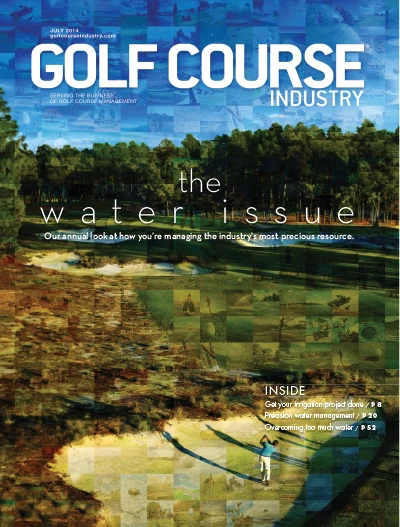
 John Kaminski John Kaminski |
For those who watched the men’s and women’s U.S. Open at Pinehurst, it was clear the USGA was sending a message. That message was golf courses have the opportunity to reduce water and on a larger scale lessen the inputs which will ultimately benefit the environment. Whether you agree or not depends a lot about the membership expectations at your individual course. What was done at No. 2 was amazing. I’m a huge fan and it’s probably one of the best restorations in my lifetime. Unfortunately, the dramatic look of the course and reduced inputs which led to the brown appearance resulted in polarizing opinions. I’m pretty sure it wasn’t the intention or opinion of the USGA to say this type of dramatic renovation and maintenance practices is right for every golf course. Unfortunately, the polarized nature of many viewers led to some far-reaching thoughts. I followed several conversations on Twitter during the event and there were plenty of opinions being shared. Below are a few of my favorites. Jason Goss (@gossturf) said, “If you don’t like or understand the look and playability of Pinehurst No. 2 this week, then you are what’s wrong with golf.” Although I understood the look at Pinehurst this week, I can certainly sympathize with those who didn’t, so maybe I’m what’s wrong with golf. Riding the fence was Brandon Horvath (@UTTurfPath). In a variety of discussions, Brandon stated what a lot of us in academia and probably the industry were thinking, that the message should be “about how GCS’s are exc. stewards of their resources (incl. H2O). And less about how much less.” Brandon is spot on. If we continue to put numbers on what a course like Pinehurst can conserve, then those same numbers may ultimately be the standard for other courses that operate under completely different circumstances. On the other side, was the always opinionated Donald Trump (@realDonaldTrump) who ruffled feathers during the U.S. Open. The best conversation was with Golf Channel’s Matt Ginella (@MattGinellaGC). Trump ultimately ended that conversation with “@MattGinellaGC Sadly Matt, you don’t understand golf (even though you think you do). I have numerous couses [sic] that are far superior to Pinehurst.” He clarified his thoughts on the course with, “The only reason I am critical of the Pinehurst look is because I’m a lover of golf – and that look on TV hurts golf badly.” The bottom line is superintendents are stewards of the land, environmentalists and conservationists. Does this mean every course should – and more importantly “can” – look like Pinehurst? The answer is obviously “no” for a variety of reasons, but I think that’s not what the USGA was saying. They’re much smarter than that, but they also know that you sometimes have to make a huge statement to drive a message home. The message is we can all do more to reduce our inputs, conserve water and reduce pesticides. It wasn’t their intention to suggest every course should use single-row irrigation, remove their rough and convert to Bermudagrass. In watching some interviews, the message was clear that the unique situation at Pinehurst resulted in some dramatic savings in water usage among other things. Dr. Kim Erusha stated it best when she said, “Pinehurst is a unique location… If we can use less water resources in those areas, we can save not only a lot of money, but we can also make that a lot more environmentally beneficial, as well.” I don’t believe anyone is going to argue with the benefits of that message or the results on this “unique” piece of sandy property. Conservation and reductions in water usage are going to be at the heart of policy pertaining to the golf course industry in the coming years. While the men’s and women’s U.S. Open at Pinehurst highlighted some of the ways courses are reducing their inputs, I hope it’s not spun in a way that all golf courses should be maintained in that manner. What makes courses unique are their own special characteristics. Pinehurst now has its own, but so does Augusta National. Is one right and the other wrong? I don’t think so. They’re both unique and that’s what makes them special. The most interesting thing was as this was going on, Trump announced his acquisition of Turnberry, one of the world’s greatest links courses. Turnberry, which has hosted four Open Championships, is known for its browned-out fairways that are firm and fast in true links fashion. If Trump’s comments about Pinehurst are any indication, you can expect a different “look” to Trump Turnberry moving forward. The big question will be whether the R&A sees these potential changes as a reason to exclude the course from its Open rotation.
John E. Kaminski, Ph.D. is an associate professor, Turfgrass Science, and director of the Golf Course Turfgrass Management Program at Penn State University. You can reach him at kaminski@psu.edu. |

Explore the July 2014 Issue
Check out more from this issue and find your next story to read.
Latest from Golf Course Industry
- Carolinas GCSA raises nearly $300,000 for research
- Advanced Turf Solutions’ Scott Lund expands role
- South Carolina’s Tidewater Golf Club completes renovation project
- SePRO to host webinar on plant growth regulators
- Turfco introduces riding applicator
- From the publisher’s pen: The golf guilt trip
- Bob Farren lands Carolinas GCSA highest honor
- Architect Brian Curley breaks ground on new First Tee venue







